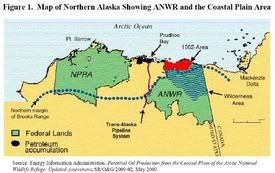We've heard from supporters that this is critical to our energy indepence, and that if the original bill for drilling had been authorized a decade ago, we'd be enjoying the benefits of that delectable Alaskan oil today. We've heard from the opponents that this would destroy a pristine wilderness, and wont really affect the overall picture much, anyway.
So, I figured it was time to go to the ultimate source on this one: The DOE Energy Information Administration. Here's the quick overview on ANWR; It's located up on the northern coast of Alaska, east of Prudhoe Bay, "the largest oil field ever discovered in the United States".

The EIA Analysis Summary was last updated in Jun 2004, so the dates referenced are probably going to be off by about two years.
Because of the nature of oil drilling, it's anticipated that it will take between 7-12 years from authorization to initial production. As the Analysis Summary states: "The opening of the ANWR 1002 Area to oil and gas development is projected to increase domestic oil production starting in 2013." So, if this was authorized, we're looking at roughly a decade from opening the area for drilling and the initial "opening of the taps". From that point, it will take more time until peak production can be acheived. "In 2025, the coastal plain of ANWR is projected to reach 0.9 million barrels per day under the USGS mean oil resource case, and 0.6 and 1.6 million barrels per day under the low and high resource cases, respectively."
In other words, in 2025 we can expect to hit peak production of between 0.6MBD and 1.6MBD, with a mean estimate of 0.9MBD.
How will that affect our dependence on imported oil?
Petroleum imports are projected to decline one barrel for every barrel of ANWR production. Opening the coastal plain of ANWR is projected to reduce 2025 oil import dependence from 70 percent in the AEO2004 reference case to 66 percent in the mean resource case. The high and low oil resource cases project a 2025 oil import dependency of 64 percent and 67 percent, respectively.So, in the best of cases, given the information we know, we'll be reducing our import dependence from 70% to 64%. I've got to admit that the "it wont make much of a difference" argument seems to have some weight behind it.
For the hell of it, I just wanted to take a look at some absolute BPD import numbers, just to get a sense of what ANWR peak production means. From here, we find that in 2004, the US had net petroleum imports of ~ 12 million BPD. So, the anticipated peak production of ANWR would be the equivalent of between 5%-13.3% of our what we're currently importing. At best, this could be considered a start.
So the effects of full ANWR production towards reducing imported petroleum is decades away, and the impact is, at best, small. Does it make us independent of Middle East oil? On the basis of this information, I'm saying; "hell, no!" So, frankly, if this is being justified on the basis of ecomonic impact to Alaska, there's an argument, but from the "independence from imported oil perspective," I'm sure not seeing it.
No comments:
Post a Comment